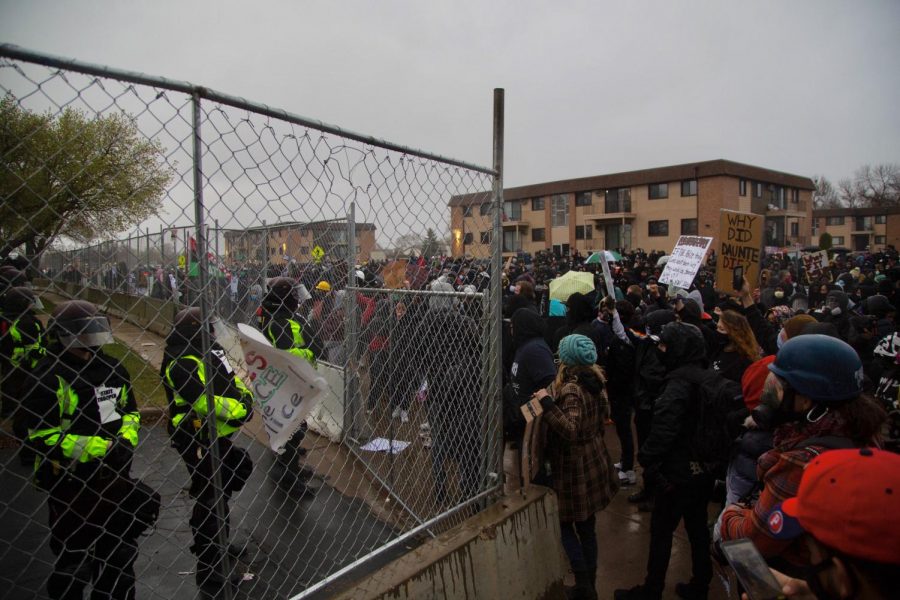After a Brooklyn Center police officer shot and killed 20-year-old Daunte Wright on Sunday, the tension weighing down an already heavy Minnesota erupted — echoing protests for George Floyd that wracked the state almost a year ago.
Wright’s death comes in the middle of the murder trial of former Minneapolis police officer Derek Chauvin for the death of Floyd, who died after being pinned under Chauvin’s knee for over nine minutes. Veteran police officer Kim Potter shot Wright, a young Black man, after he tried to flee from police following a traffic stop. Potter trained less experienced officers in the field.
Both Potter and Brooklyn Center police chief Tim Gannon resigned Tuesday.
The timing of Wright’s death, community leaders said, is not lost on Minneapolis and the surrounding cities, as many of the same messages from last summer’s protests rang out over megaphones.
“This is tiring, like the police can’t go a week without murdering someone,” said Jae Yates, organizer with Twin Cities Coalition for Justice 4 Jamar. “We also really just want to rally around getting justice for this case and making sure that the police department doesn’t get to just investigate this themselves.”
The second night of protests on Monday looked much like those on Sunday night, save a curfew from 7 p.m. to 6 a.m. for Hennepin, Ramsey, Anoka and Dakota counties. By 6 p.m. on Monday, roughly 400 protesters gathered outside the Brooklyn Center Police Department. Police officers remained behind barricades set up around the department building for most of the night.
In Brooklyn Center for @mndailynews following the police shooting of Daunte Wright. Look to be about 400 people. Some are leaving, as the multi-county curfew begins at 7 p.m. Some are just arriving. pic.twitter.com/2vaB7EVILh
— Samantha Hendrickson (@samanthajhendr) April 12, 2021
By the time the curfew hit, the numbers doubled, despite law enforcement calling for dispersal. Speakers at the gathering asked protesters to leave before curfew, encouraging them to get home safely to their loved ones. Neighbors huddled, filming the events at apartment doors and down the street.
Police and state patrol officers in riot gear began firing pepper balls, flashbangs and tear gas into the crowds around 8:30 p.m., eventually forming a line to split the throng and push the protesters north along Humboldt Avenue. For the second night in a row, nearby residences were blanketed in tear gas.
Throughout the night, protesters threw plastic water bottles and broken bricks at the officers, and returned the flash bangs shot at them with fireworks.
Protesters shoot off fireworks and police shoot off flash bangs, tear gas and smoke while a large amount of officers advance (looks like hundreds?). pic.twitter.com/9Z47nb3AIM
— Lydia Morrell (@lydia_morrell) April 13, 2021
Gov. Tim Walz said in a press conference Monday that the largest police presence in Minnesota history would be deployed that night.
Police and state patrol are on the move. pic.twitter.com/96ai5yRoXl
— Samantha Hendrickson (@samanthajhendr) April 13, 2021
Police deployed flash bangs. pic.twitter.com/6S7eoKHI20
— Lydia Morrell (@lydia_morrell) April 13, 2021
By 10 p.m., law enforcement reached the Humboldt Avenue strip mall where people had broken into the Dollar Tree and looted merchandise. Officers shot off multiple flashbangs, and most of the remaining protesters dispersed.
Forty people were arrested on the second night of protests in Brooklyn Center for charges from “curfew violations all the way to riot,” said Col. Matt Langer of the Minnesota State Patrol during a press briefing. Minneapolis police made ten arrests for curfew violations or burglary.
Black Lives Matter Twin Cities Metro organizer and middle school teacher Satara Strong-Allen said she wants Potter indicted and convicted for shooting Wright. She added it has been “very traumatizing” for her to see another Black man killed, particularly one who was close in age to the students that she teaches.
“I have to look [my students] in the face every day and reassure them that everything’s gonna be okay and love on them and process all the things that they go through, not only in the education system but just day-to-day living in their Black body,” Strong-Allen said.













